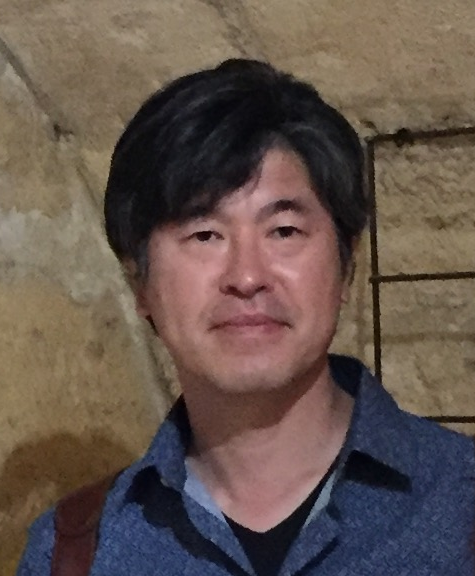| Program B01-3 | Muon analysis procedures for carbonaceous material in samples recovered by Hayabusa2 asteroid sample return mission |
|---|---|
| Principal Investigator | NAKAMURA, Tomoki (Tohoku University) |
Hayabusa2 mission was developed based on heritage of Hayabusa mission
that realized the first successful recovery of asteroidal sample to
the Earth. Hayabusa2 spacecraft was launched in Nov 2014, arrived at
C-type asteroid Ryugu around July 2018, and succeeded to collect
surface samples in 2019. It was coming back to the Earth in 2020 and
initial analysis of the returned samples will start from June
2021. Ryugu is classified to C-type asteroids that are expected to
contain high abundance of organic material. Remote sensing
observation from the spacecraft showed that the asteroid shows
spinning top shape with diameter of 900m and very low density
(1.2 g/cc) (Watanabe et al. (2019)), suggesting that
Ryugu is not a
first-generation asteroid but a rubble-pile asteroid formed by
re-accretion of impacted and disrupted first-generation asteroid. The
reflectance spectra in the visible and near-infrared wavelength
indicate that the surface is very dark and homogeneous and hydrated
minerals are distributed on the entire surface
(Sugita et al. (2019): Kitazato et al. (2019)).
 Fig. 1. Asteroid Ryugu (left: ∼900 m in diameter)
and surface rock (right: the figure width is ∼1 m)
Fig. 1. Asteroid Ryugu (left: ∼900 m in diameter)
and surface rock (right: the figure width is ∼1 m)
Nakamura, the principal investigator of this study, is a member of
the initial analysis group, which is the first group to analyze the
samples recovered from Ryugu, and is the leader of the team that
analyzes coarse (1–5 mm in diameter) particles among the
recovered samples. A final rehearsal analysis was performed in
April 2021 at
J-PARC MLF on a carbonaceous meteorite that is expected to be similar
to the Ryugu sample, and it was confirmed that carbon can be
quantified with high precision with an exposure to negative muon for
about five days.
Nakamura has been engaged in material science research on
carbonaceous meteorites flying from C-type asteroids for
30 years and is familiar with these meteorites. In addition, he
has participated as a core member in past sample return missions,
systematically analyzing comet-recovered samples and asteroid samples
recovered by Hayabusa (first) mission to elucidate the materials of
primitive solar system bodies and to study the evolution of the early
solar system. We would like to elucidate the formation and evolution
process of the C-type asteroid Ryugu by comprehensively analyzing the
samples recovered by Hayabusa2. In this context, the carbon
concentration to be determined in this study is a fundamental
elemental abundance that characterizes the C-type asteroid Rryugu,
and is an important chemical data that serves as an indicator of the
organic content of the asteroid. Since this analysis is
non-destructive, it can be performed using about 100 mg of a valuable
Ryugu sample. The measured samples will be subjected to various
mineralogical and chemical analyses to clarify the formation and
evolution history of asteroid Ryugu in the early solar sysytem.
Members
- Principal Investigator
-
NAKAMURA, Tomoki

(Graduate School of Science, Tohoku University)
- Research Collaborators
-
NINOMIYA, Kazuhiko (Osaka University)
TAKAHASHI, Tadayuki (University of Tokyo (Kavli IPMU))
OSAWA, Takahito (Japan Atomic Energy Agency (JAEA))
WADA, Taiga (Tohoku University)
Reference Materials
-
T. Morota ,T. Nakamura (30th/95 authors), et al., “Sample collection from asteroid (162173) Ryugu by Hayabusa2: Implications for surface evolution,” Science 368, 654–659 (2020). -
S. Watanabe ,T. Nakamura (12th/88 authors), et al., “Hayabusa2 observations of the spinning-top-shaped carbonaceous asteroid 162173 Ryugu,” Science 364, 268–272 (2019). -
K. Kitazato ,T. Nakamura (8th/58 authors), et al., “Surface composition of asteroid 162173 Ryugu as observed by the Hayabusa2 NIRS3 instrument,” Science 364, 272–275 (2019). -
S. Sugita ,T. Nakamura (27th/120 authors), et al., “The geomorphology, color, and thermal properties of Ryugu: Implications for parent-body processes,” Science 364, eaaw0422 (2019). -
T. Nakamura et al. , “Itokawa dust particles: A direct link between S-type asteroids and ordinary chondrites,” Science 333, 1113–1116 (2011). -
T. Noguchi ,T. Nakamura , et al., “Incipient space weathering observed on the surface of Itokawa dust,” Science 333, 1121–1125 (2011). -
K. Nagao ,R. Okazaki ,T. Nakamura , et al, “Irradiation history of Itokawa regolith material deduced from noble gases in the Hayabusa samples,” Science 333, 1128–1131 (2011). -
T. Nakamura ,T. Noguchi ,A. Tsuchiyama ,T. Ushikubo ,N. T. Kita ,J. W. Valley ,M. E. Zolensky ,Y. Kakazu ,K. Sakamoto ,E. Mashio ,K. Uesugi , andT. Nakano , “Chondrulelike objects in short-period comet 81P/Wild 2,” Science 321, 1664–1667 (2008).
